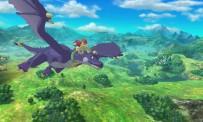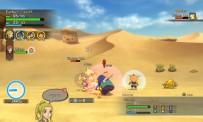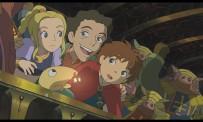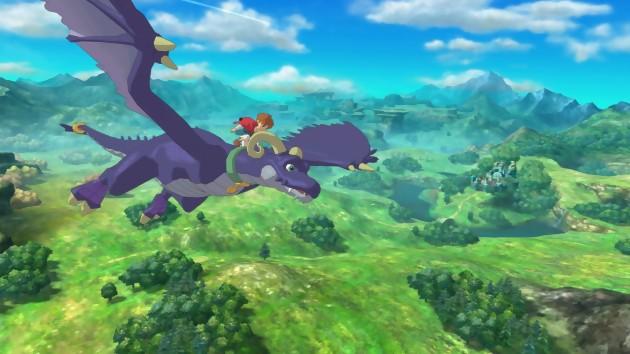 Cute, detailed, inspired, colorful, Ni no Kuni DS version dipped into visual qualifiers but remained stuck in small laptop screens, frustratingly limiting at the thought of movie sessions dedicated to a Miyazaki film. Its arrival on Playstation 3 therefore appeared as a kind of logical consequence, honoring in HD the artistic direction of Ghibli's creatives, without betraying the existing script. The story therefore always revolves around the young Oliver, who watches helplessly as his mother dies. Deeply touched by this loss, the young boy will find a certain comfort in Lumi, his old stuffed toy which has suddenly come back to life under the action of his tears. An installation of discreet, sober and touching magic as often in Ghibli productions. The fantastic comes from the sides, through the children, and then speaks to the adult, at least to his childish part. An important theme which is also that of the Level-5 game, the young heroes constantly trying to rally the "responsible" figures to their cause. An odyssey which oscillates between two worlds, the real one of Oliver and the fantasized one of Lumi. Interconnected, the latter act in concert and the actions undertaken on a character of one of them have immediate consequences on his double, the soul mate, on the other side. An excellent idea of game-design which is only used very partially, simple articulation around which revolves some basic main quests, even if it often requires many steps. Most of the adventure will take place, however, in the world of Ni no Kuni, a land made up of several islands with very different landscapes and specific cultures, divided between kingdoms. From states ruled by dissolvable monarchs in the Ghibli style, from the immense queen in bovine finery, to the Cat King and the porcine regent, the imaginative codes of the Japanese studio never fail in Ni no Kuni, while giving the clear impression of participating in a mashup of original feature films. Visually stunning, Ni no Kuni: Revenge of the Celestial Witch brings together abundance in every shot. An outbreak of details, small coherent finds, in a heap, a creative chaos that pushes to observe all the nuances with a movement of the camera. Decors that have a character, stirred by discreet animations, but sufficiently present to diffuse this flow of life which makes them credible environments. An immersive work that resonates with the obvious relationship to an animated film, where visual dynamism is one of the main conditions in the delicate business of capturing attention. A tacit contract that hands down a game that stumbles as soon as it leaves its contemplative side.
Cute, detailed, inspired, colorful, Ni no Kuni DS version dipped into visual qualifiers but remained stuck in small laptop screens, frustratingly limiting at the thought of movie sessions dedicated to a Miyazaki film. Its arrival on Playstation 3 therefore appeared as a kind of logical consequence, honoring in HD the artistic direction of Ghibli's creatives, without betraying the existing script. The story therefore always revolves around the young Oliver, who watches helplessly as his mother dies. Deeply touched by this loss, the young boy will find a certain comfort in Lumi, his old stuffed toy which has suddenly come back to life under the action of his tears. An installation of discreet, sober and touching magic as often in Ghibli productions. The fantastic comes from the sides, through the children, and then speaks to the adult, at least to his childish part. An important theme which is also that of the Level-5 game, the young heroes constantly trying to rally the "responsible" figures to their cause. An odyssey which oscillates between two worlds, the real one of Oliver and the fantasized one of Lumi. Interconnected, the latter act in concert and the actions undertaken on a character of one of them have immediate consequences on his double, the soul mate, on the other side. An excellent idea of game-design which is only used very partially, simple articulation around which revolves some basic main quests, even if it often requires many steps. Most of the adventure will take place, however, in the world of Ni no Kuni, a land made up of several islands with very different landscapes and specific cultures, divided between kingdoms. From states ruled by dissolvable monarchs in the Ghibli style, from the immense queen in bovine finery, to the Cat King and the porcine regent, the imaginative codes of the Japanese studio never fail in Ni no Kuni, while giving the clear impression of participating in a mashup of original feature films. Visually stunning, Ni no Kuni: Revenge of the Celestial Witch brings together abundance in every shot. An outbreak of details, small coherent finds, in a heap, a creative chaos that pushes to observe all the nuances with a movement of the camera. Decors that have a character, stirred by discreet animations, but sufficiently present to diffuse this flow of life which makes them credible environments. An immersive work that resonates with the obvious relationship to an animated film, where visual dynamism is one of the main conditions in the delicate business of capturing attention. A tacit contract that hands down a game that stumbles as soon as it leaves its contemplative side.Oliver du Bourg Palette
 Unlike the DS episode which had inherited a rather sluggish turn-based combat system, Ni no Kuni: Revenge of the Celestial Witch benefited from an adjustment at this level with the presence of a sort of the Tales Of, which allows you to act in real time, in the heart of the action, but within the limits of the reloading of attacks. Depending on the type and power of the chosen assault, the time required for its new use is more or less long. An element to take into account quickly, the enemies are also very mobile. They do not hesitate to rush towards the player without giving him time to refine his strategy and it is therefore very important, once accompanied by two thieves, to create a balanced and coherent team. Because in the majority of cases, it is not the "human" heroes who will take part in the battle, but their Pokémon of circumstance. Like the wild animal traffickers of the Nintendo series, it is possible to recruit all the critters that serve as common enemies by using the charm abilities of young Myrta. All you have to do is weaken them until a small heart appears above their head before casting a spell on them in a short period of time. If this icon appears very randomly, the capture itself is simple, which allows you to have a cohort of monsters quite early in the adventure. Requiring healing, your pets can be fed foods that increase specific stats like attack, defense, magic defense, accuracy, and other stats, as well as equipped from head to tail via a choice of parts equipment that matches their fighting style. Of course, wizard-style creatures have ridiculous defense, while warrior-types are slow but resilient tanks. It is therefore necessary to take these strengths and weaknesses into account when distributing them, because once summoned, they share the life and magic gauges with the heroes. This means that if your valiant Minimi or your fabulous Bêêêligérant succumbs to enemy blows, his trainer dies with him. A principle which, it is a good thing, obliges to be very attentive during the passes-of-arms, but which suffers from a frightening lack of adjustment. That's the bad thing.
Unlike the DS episode which had inherited a rather sluggish turn-based combat system, Ni no Kuni: Revenge of the Celestial Witch benefited from an adjustment at this level with the presence of a sort of the Tales Of, which allows you to act in real time, in the heart of the action, but within the limits of the reloading of attacks. Depending on the type and power of the chosen assault, the time required for its new use is more or less long. An element to take into account quickly, the enemies are also very mobile. They do not hesitate to rush towards the player without giving him time to refine his strategy and it is therefore very important, once accompanied by two thieves, to create a balanced and coherent team. Because in the majority of cases, it is not the "human" heroes who will take part in the battle, but their Pokémon of circumstance. Like the wild animal traffickers of the Nintendo series, it is possible to recruit all the critters that serve as common enemies by using the charm abilities of young Myrta. All you have to do is weaken them until a small heart appears above their head before casting a spell on them in a short period of time. If this icon appears very randomly, the capture itself is simple, which allows you to have a cohort of monsters quite early in the adventure. Requiring healing, your pets can be fed foods that increase specific stats like attack, defense, magic defense, accuracy, and other stats, as well as equipped from head to tail via a choice of parts equipment that matches their fighting style. Of course, wizard-style creatures have ridiculous defense, while warrior-types are slow but resilient tanks. It is therefore necessary to take these strengths and weaknesses into account when distributing them, because once summoned, they share the life and magic gauges with the heroes. This means that if your valiant Minimi or your fabulous Bêêêligérant succumbs to enemy blows, his trainer dies with him. A principle which, it is a good thing, obliges to be very attentive during the passes-of-arms, but which suffers from a frightening lack of adjustment. That's the bad thing.One for all, all dead
 Completely morons, there are no other words, the teammates directed by the AI are unable to carry out actions at least coherent. As long as it relates to pure and simple attack, things are going well, but as soon as support comes into play, it's best to take everything that happens with humor. In a kind of comfort, the game offers to define the strategy of the other members of the team with simple action plans: unreasonable attack, healing, support, passivity, etc. Effective except when deafness wreaks havoc in your ranks. Barely changing their pattern, your teammates persist in healing themselves too late, not using items, and above all never putting themselves on defense alone. It is necessary for that to launch a general command which besides puts more or less time to be put into practice. Suffice to say that against the many and very devious bosses of the game, specialists in special moves that it is imperative to counter every 30 seconds, the situations are complicated. Even headaches due to simple poor balance management. The only alternative is to spend hours, hours and more hours grinding like in an old Final Fantasy, not to feel powerful and exceed the limits set by the game, but to compensate for the filthy stupidity of the AI Suffice to say that the motivation is not one. Seeing everyone around you die becomes a habit, and it is really not uncommon to end up solo with the character that the player is controlling, the only survivor of a collective suicide. A wobbly system as possible which does not prevent progress and even less to take a certain pleasure in the fact of managing its critters on the fly in order to stick to a changing situation, but which handicaps a game in which the fight occupies a part important to gameplay.
Completely morons, there are no other words, the teammates directed by the AI are unable to carry out actions at least coherent. As long as it relates to pure and simple attack, things are going well, but as soon as support comes into play, it's best to take everything that happens with humor. In a kind of comfort, the game offers to define the strategy of the other members of the team with simple action plans: unreasonable attack, healing, support, passivity, etc. Effective except when deafness wreaks havoc in your ranks. Barely changing their pattern, your teammates persist in healing themselves too late, not using items, and above all never putting themselves on defense alone. It is necessary for that to launch a general command which besides puts more or less time to be put into practice. Suffice to say that against the many and very devious bosses of the game, specialists in special moves that it is imperative to counter every 30 seconds, the situations are complicated. Even headaches due to simple poor balance management. The only alternative is to spend hours, hours and more hours grinding like in an old Final Fantasy, not to feel powerful and exceed the limits set by the game, but to compensate for the filthy stupidity of the AI Suffice to say that the motivation is not one. Seeing everyone around you die becomes a habit, and it is really not uncommon to end up solo with the character that the player is controlling, the only survivor of a collective suicide. A wobbly system as possible which does not prevent progress and even less to take a certain pleasure in the fact of managing its critters on the fly in order to stick to a changing situation, but which handicaps a game in which the fight occupies a part important to gameplay. The only alternative is to spend hours, hours and more hours grinding like in an old Final Fantasy"
 A laborious step-by-step progress which also owes a good part of its slowing down to an evolution principle which forces monsters modifying their class to return to level 1. Nothing serious if they are allowed to gain experience without being included in the team. Which is not the case. The plan is then to walk around with a familiar that is almost useless for a few hours, just to propel it to a decent level before finally being able to reuse it. A find that itself breaks any desire to change rank, even if the advantages are numerous, especially in terms of diversity of actions, once returned to equality with the other monsters. Leaving turn-based for a bias more action Ni No Kuni PS3 still failed to overcome the stigma of problematic gameplay that sticks to him decidedly skin. And on this point that everything is played. Because Level-5's game is breathless on its universe, its smiling animated sequences and its nonchalance full of an intoxicating plastic beauty. An old-fashioned adventure, with certainly its quests a little honeyed, its invisible walls in every corner and its inconsistencies which smell good of the 90s, but which grabs, precisely by its simplicity. The only and big problem is to know if this notion, present, of pure adventure is enough to override a badly done combat system, bomb with boredom. That wasn't the case in Dragon Quest 8, it's not here. By making a few concessions, adorned with a Ghibli fan hat, some things can pass in a few hours, a certain agreement can be put in place. But as it stands, Ni no Kuni: Revenge of the Celestial Witch is clearly an average RPG with exceptional charm.
A laborious step-by-step progress which also owes a good part of its slowing down to an evolution principle which forces monsters modifying their class to return to level 1. Nothing serious if they are allowed to gain experience without being included in the team. Which is not the case. The plan is then to walk around with a familiar that is almost useless for a few hours, just to propel it to a decent level before finally being able to reuse it. A find that itself breaks any desire to change rank, even if the advantages are numerous, especially in terms of diversity of actions, once returned to equality with the other monsters. Leaving turn-based for a bias more action Ni No Kuni PS3 still failed to overcome the stigma of problematic gameplay that sticks to him decidedly skin. And on this point that everything is played. Because Level-5's game is breathless on its universe, its smiling animated sequences and its nonchalance full of an intoxicating plastic beauty. An old-fashioned adventure, with certainly its quests a little honeyed, its invisible walls in every corner and its inconsistencies which smell good of the 90s, but which grabs, precisely by its simplicity. The only and big problem is to know if this notion, present, of pure adventure is enough to override a badly done combat system, bomb with boredom. That wasn't the case in Dragon Quest 8, it's not here. By making a few concessions, adorned with a Ghibli fan hat, some things can pass in a few hours, a certain agreement can be put in place. But as it stands, Ni no Kuni: Revenge of the Celestial Witch is clearly an average RPG with exceptional charm.






























